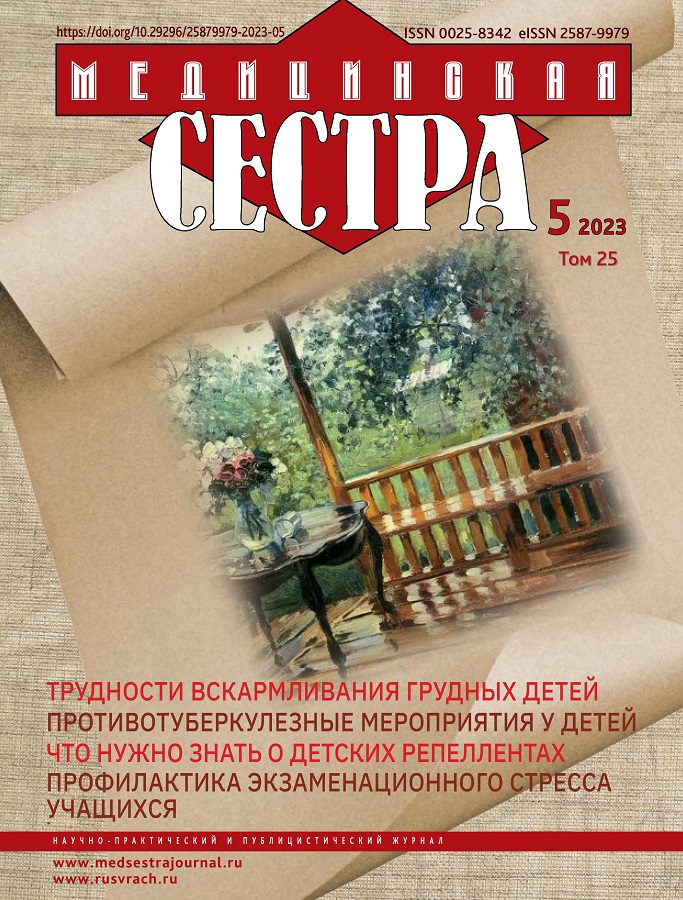Клиническое наблюдение за новорожденным ребенком с врожденным буллезным эпидермолизом. Роль медицинской сестры
- Авторы: Черненков Ю.В.1, Панина О.С.1, Плохоцкая Л.С.1
-
Учреждения:
- ФГБОУ ВО «Саратовский государственный медицинский университет им. В.И. Разумовского» Минздрава РФ
- Выпуск: Том 25, № 5 (2023)
- Страницы: 33-36
- Раздел: Профессия: теория и практика
- URL: https://journals.eco-vector.com/0025-8342/article/view/568017
- DOI: https://doi.org/10.29296/25879979-2023-05-07
- ID: 568017
Цитировать
Полный текст
Аннотация
В настоящее время существует большая потребность в расширении знаний в отношении буллезного эпидермолиза у ново- рожденных. Это связано с трудностью проведения дифференциальной диагностики. Осведомленность о данном заболевании позволит избежать ошибок в постановке диагноза и позволит назначить правильное лечение пациенту. Цель работы – представление клинического случая врожденного буллезного эпидермолиза у новорожденного ребенка, родившегося в 2022 году в Саратовской области. Произведен анализ медицинской документации, течение неонатального периода пациента с диагнозом «врожденный буллезный эпидермолиз».
Результаты. В данной работе на примере конкретной клинической ситуации выделены и описаны характерные особенности клиники и диагностики данного заболевания. Основное содержание работы составляет сравнение инфекционных и неинфекционных заболеваний кожи. Особое внимание уделено вопросам дифференциальной диагностики в связи с трудностями в ее проведении.
Заключение. Буллезная экзантема отмечается при многих воспалительных заболеваниях кожи, в связи с чем необходима дифференциальная диагностика врожденного буллезного эпидермолиза с пузырчаткой новорожденных, синдромом недержания пигмента.
Осведомленность о заболевании позволит избежать ошибок в назначении лечения пациенту, так как тактика обработки кожных покровов при ВБЭ и инфекционных заболеваниях кожи различается (противопоказано использовать анилиновые красители на спиртовой основе).
Для улучшения кожного барьера и самочувствия детей-бабочек необходим правильный уход с самого рождения. Защита хрупкой кожи от повреждения, обработка и перевязка ран – пожалуй, единственное на сегодняшний день, чем можно помочь таким детям. Для наружного лечения используют специальные перевязочные материалы и мази с целью уменьшения болезненности и предотвращения инфицирования.
На сегодняшний день все больше детей-бабочек имеют возможность получать квалифицированную помощь, необходимые медикаменты и перевязочные средства благодаря деятельности благотворительного фонда «Б.Э.Л.А. Дети-бабочки».
Полный текст
Об авторах
Юрий Валентинович Черненков
ФГБОУ ВО «Саратовский государственный медицинский университет им. В.И. Разумовского» Минздрава РФ
Автор, ответственный за переписку.
Email: chernenkov64@mail.ru
ORCID iD: 0000-0002-6896-7563
доктор медицинских наук, профессор, заведующий кафедрой госпитальной педиатрии и неонатологии
Россия, СаратовОльга Сергеевна Панина
ФГБОУ ВО «Саратовский государственный медицинский университет им. В.И. Разумовского» Минздрава РФ
Email: olga.panina.74@mail.ru
ORCID iD: 0000-0003-3387-4321
кандидат медицинских наук, доцент кафедры госпитальной педиатрии и неонатологии
Россия, СаратовЛариса Сергеевна Плохоцкая
ФГБОУ ВО «Саратовский государственный медицинский университет им. В.И. Разумовского» Минздрава РФ
Email: larisa.plokhotskaya@mail.ru
студентка
Россия, СаратовСписок литературы
- Альбанова В.И., Гольченко В.А. Лечение буллезного эпидермолиза. Российский журнал кожных и венерических болезней. 2013; 4: 21–24.
- Альбанова В.И., Чикин В.В., Епишев Р.В. К вопросу о диагностике врожденного буллезного эпидермолиза. Вестник дерматологии и венерологии. 2014; (3): 53–59.
- Буллезный эпидермолиз / под ред. Дж.-Д. Файна и Х. Хинтнера. - М: Практика, 2014. с. 357.
- Гаджимурадов М.Н., Гаджимурадова К.М., Алиева М.Г. и др. Врожденный буллезный эпидермолиз. Клинические особенности и собственные наблюдения. Клиническая дерматология и венерология. 2020; 19 (5): 647-654.
- Кубанов А.А., Альбанова В.И., Карамова А.Э. и др. Распространенность врожденного буллезного эпидермолиза у населения Российской Федерации. Вестник дерматологии и венерологии. 2015; 3: 21–30.
- Кубанов А.А., Карамова А.Э., Чикин В.В. и др. Эпидемиология и состояние оказания медицинской помощи больным врожденным буллезным эпидермолизом в Российской Федерации. Вестник РАМН. 2018; 73 (6): 420–430.
- Кубанов А.А., Альбанова В.И., Чикин В.В. и др. Современные методы терапии врожденного буллезного эпидермолиза. Вестник дерматологии и венерологии. 2014; 6: 47–56.
- Мурашкин Н. Н., Намазова-Баранова Л. С. Буллезный эпидермолиз: руководство для врачей. ПедиатрЪ. 2019. с. 444.
- Сердюкова Е.А., Попов В.В. Лечение врожденного буллезного эпидермолиза у детей. Лекарственный вестник. 2016; 10 (4) (64): 43–47.
- Союз педиатров России. Врождённый буллёзный эпидермолиз: клинические рекомендации. 2020. с. 65.
- Бенова Н.В., Григорьев К.И., Коваленок К.В. Помощь детям с буллезным эпидермолизом: паллиативные пути решения проблемы. Медицинская сестра. 2013; 8: 38–44.









